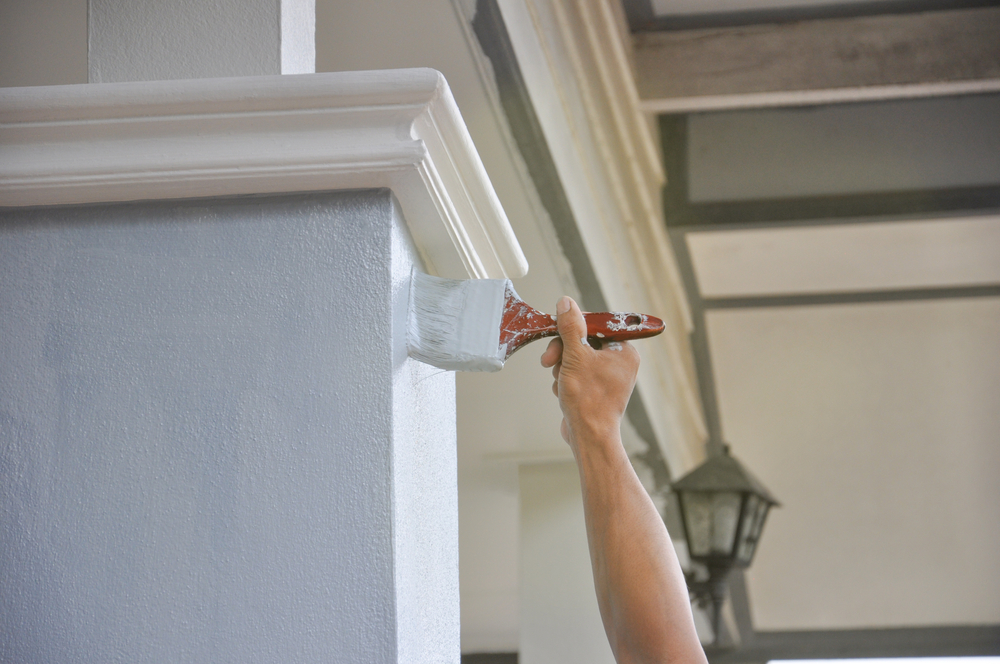Table of Contents
ToggleA painting project is widely recognized as one of the most effective ways to refresh any space, whether it’s a home or a commercial area. While the end result of all painting projects is generally the same—a beautiful new look—the methods and costs can vary significantly. This raises one of the first questions that most people planning a painting project ask themselves: Is commercial painting more expensive than residential painting? The short answer is: it depends.
Both types of paint jobs ultimately enhance the appearance of a space’s interior and exterior. However, the methods and process of this application can differ greatly based on factors like the scope, materials, labor, and overall complexity of the project. This is natural because residential and commercial spaces are not the same.
Residential spaces tend to be much smaller, so the scope of these painting projects is also smaller, like painting a home or apartment. This means that paint jobs at these locations are quicker and do not require as many painters or tools.
Conversely, commercial spaces tend to be bigger buildings, such as office buildings, retail spaces, and warehouses. These painting projects require more preparation, specialized tools, safety considerations, and painters.
To answer whether commercial painting is more expensive than residential, one should also consider the different functions of these types of spaces. Commercial spaces see far more traffic than residential spaces, so they will have different requirements in terms of the type of paint used, the number of coats needed, and the surface preparation.
Residential painting projects don’t necessarily require as durable paint as commercial projects since they tend to be more about appearance. Commercial painting jobs also require workers to be more flexible with their working hours to accommodate the business, which can increase costs.
So, is commercial painting more expensive than residential painting? Based on everything that was previously stated, it might seem like a definite ‘yes.’ However, that is not necessarily always the case. This is why it’s important to understand the factors that impact painting costs for commercial and residential projects, which helps with knowing what to expect and how to budget accordingly.
Understanding the Differences Between Commercial and Residential Painting Projects

Residential painting focuses on using paint to enhance one’s home, whether a cozy house or a spacious apartment. Since these projects are conducted in personal living spaces, they typically emphasize aesthetics, comfort, and individuality, contrasting with commercial projects that prioritize the functionality of the paint job over its visual appeal.
This doesn’t mean that durable paints and techniques can’t be used in residential painting; they just aren’t the primary motivation behind the project.
When planning a residential painting project, homeowners typically hire painters for both interior and exterior work to achieve a final appearance that suits their tastes and the design of their homes.
To accurately answer the question, ‘Is commercial painting more expensive than residential?‘ one must first examine factors such as scale, labor, project complexity, and tools, all of which can impact painting costs in different ways.
Key Differences Between Commercial and Residential Painting Costs
- The Scale of the Project:
This is the most obvious difference between commercial and residential painting projects. The scale of each project directly correlates to the scope of work required, including the amount of materials and workers needed and the duration of the painting project.
- Smaller buildings: Residential painting projects are usually much smaller in scale than commercial projects because residential buildings are smaller in size.
- Fewer painters: Because these jobs are physically smaller in scale, they usually do not need as many workers or specialized tools and equipment, contributing to lower costs.
- Less time: While residential painting projects are usually completed in days or weeks, large commercial properties can have paint jobs that last many months. The bigger buildings and other factors make the jobs more complex.
- The Complexity
The complexity of a paint job isn’t just about the size of the building, though this is a key factor. It’s also about what the space entails and what the person requesting the paint job wants done. The more complex a paint job is, the more costly it will be.
- Layouts: A home’s layout is typically much simpler than that of a commercial building, which can have spaces with industrial equipment, high ceilings, and open spaces that make work more difficult for painters.
- Customization: However, residential painting projects typically require much more customization because homeowners have specific colors and/or decorative finishes that they want for their space, which adds complexity to the job.
- Fixtures and furniture: All personal belongings must be removed or protected before a paint job can begin, which can be time-consuming and labor-intensive depending on what these items are. This can vary for both commercial and residential spaces.
Complexity is especially relevant when it comes to the needs of commercial spaces. Because of their more complex structural layouts and functional demands, these buildings tend to be more challenging than residential ones.
- Factories and Warehouses: These buildings have intense functions, so their painting materials need to withstand this intensity. This necessitates using high-durability coatings that can withstand industrial chemicals, heavy machinery, and fluctuating temperatures. Some factories may also require special coatings, such as fireproof or anti-corrosion paints, to meet safety standards, which adds to painting project costs.
- Offices and Corporate Buildings: Much like residential painting projects, paint jobs in these commercial spaces prioritize aesthetics because they need to be appealing to people. However, unlike residential spaces, offices and corporate buildings need to prioritize durability at the same time. They need to maintain a professional look while also being able to resist daily wear and tear due to high traffic, and these more durable painting materials can be more expensive. Offices may also require different more specialized painting techniques to accommodate their large open spaces, another factor that can add to costs.
- Retail Stores and Restaurants: These are the commercial spaces with the highest amount of traffic, so they tend to need the most frequent touch-ups and maintenance. These can add to painting project costs, along with any detailed brand colors and designs that the job might require.
In contrast, residential painting allows homeowners to choose from a wider range of paint types and finishes without the strict regulations that commercial buildings must follow.
- Regulations and Compliance
Residential painting projects encounter fewer regulatory issues than commercial projects, and adhering to regulations can influence costs.
- Building codes and safety regulations: These are much stricter for commercial painting than residential. Painting companies must ensure they follow fire safety rules and ADA accessibility laws and are OSHA-compliant. Following these requirements can include materials that add to the costs of painting projects and make the projects last longer, increasing costs.
- Certifications: Painting companies might also need special certifications to complete jobs and comply with safety regulations when completing commercial painting projects. Residential painting projects usually do not need special certifications unless they involve lead-based paint in older homes (pre-1978).
- Flexibility: Of course, following strict regulations can lead to less flexibility in a painting project and impact costs. Residential painting projects have more flexibility in choosing paint types, finishes, and timelines for project completion compared to commercial projects, which may have strict deadlines and material requirements.
Factors That Influence the Cost of Residential Painting

Knowing the details behind the key differences that can affect painting costs is critical to understanding the hard numbers behind each of these factors. Without the details, the numbers remain inexplicable, which makes budgeting for commercial and residential painting projects more difficult. Once the differences are examined, then one can narrow it down to the numbers behind residential painting and how to break them down.
- Labor Costs: The labor of painters accounts for most of the total cost of a residential paint job. Depending on the complexity of the project and its requirements, painters can charge between $20 and $50 per hour. If a homeowner wants more detailed work done, such as using different paint colors and finishes or intricate paint work on places like the trim, this adds to the complexity of the paint job and thus increases labor costs.
- Materials and Finishes: Residential painting projects are more flexible than commercial paint jobs, so clients have more freedom to choose the specific paint finishes and materials they want for the project. This wider selection can have varying costs depending on the quality of the chosen materials, while commercial paint jobs tend to require more durable materials to withstand their high foot traffic. When considering the costs of painting materials, the key thing to remember is that while higher-quality premium paints are more expensive up front, they are ultimately more cost-efficient in the long run because they are more long-lasting and resilient, necessitating less frequent maintenance and touch-ups.
- Timeline: This is another cost factor that ties into flexibility. Residential painting jobs can be scheduled more flexibly because they do not have to be planned around a business’s operations. However, depending on the situation, some commercial projects might have to be completed more quickly, which can also impact costs. The longer a paint job lasts, the more expensive it is likely to be. Residential paint jobs tend to be of shorter duration due to their smaller scale and scheduling flexibility, but once again, these factors can vary according to the painting project and its requirements.
Interior vs. Exterior Painting Costs
There are also different costs associated with whether a paint job is interior or exterior. Of course, the aforementioned factors, combined with the job’s specific needs, would determine the cost.
Exterior Painting
For exterior painting, there can be extra costs due to materials needing to be able to withstand exposure to the natural elements and any extra preparation that the painters might do to help the paint job last.
- Weatherproofing: Painters can use special materials like primers and paints that can withstand rain, snow, and UV exposure. These materials are common in both commercial and residential painting projects and can add to the cost of the job.
- Scaffolding and ladders: Buildings with multiple stories also add to costs because they require extra safety equipment and take more time. Commercial painting projects tend to be more expensive than residential in this regard since those buildings usually have more stories.
- Surface preparation: Many professional painting services also offer services like power washing, scraping old paint, and repairing siding that helps prepare walls and surfaces for paint application. These services can increase costs. In residential paint jobs, homeowners might decide to do some of these themselves before the painters arrive.
Interior Painting
The costs of interior painting might vary depending on the space’s complexity and the painters’ access to the areas within it. In residential painting jobs, homes with high vaulted ceilings, for example, would be harder for painters to access and require them to use specialized equipment, leading to higher costs.
When it comes to design, homes might have decorative molding or intricate trim designs that require more time and precision, which can increase costs.
Overall, residential painting projects are less expensive than commercial ones due to their smaller scale, less complexity in the project spaces, and fewer regulations. However, costs can still fluctuate depending on labor, materials, and the specific needs of the project.
Understanding these contributing factors to painting costs allows those interested in contracting professional painting services to accurately estimate the costs of what they want to enter the project with the necessary budget.
Contact us here if you would like to find the best painting contractor for your residential or commercial painting needs.
Preparing for a Commercial Painting Project

There are other budgetary factors to consider when preparing for the painting process, especially for commercial painting. Making accurate estimations is especially important for commercial painting projects because there are more extraneous factors than residential painting that can impact costs and lead to concerns down the road.
When budgeting for a commercial painting project, it’s important to consider more than just the price of paint. The total cost can include considerations like building size, surface condition (how much the painters have to do to prepare them), paint types, coatings, labor, and any other extra services that might be necessary to complete the job.
Estimating residential painting is much simpler since residential buildings typically lack the unique demands found in commercial properties. Various commercial spaces have distinct painting requirements—for example, warehouses differ significantly from storefronts or office buildings. These variations inevitably influence costs in different ways.
Understanding the cost factors below and using tools to accurately estimate project costs can help business owners make informed decisions as they enter the painting process, asking themselves, “Is commercial painting more expensive than residential?” A clear estimate ensures the project stays within budget without having to sacrifice quality.
- Cost Per Square Foot: While the cost of commercial painting can vary based on the aforementioned factors like building size and project complexity, it is still smart to have a baseline understanding of price. On average, commercial painting costs range from $2 to $6 per square foot. For example, painting a commercial building with 2,500 square feet of paintable surface may cost between $5,000 and $15,000.
- Permits: These are ‘hidden costs’ that one might not initially consider when considering commercial painting. Unlike residential painting, commercial painting may require those involved with the project to obtain permits based on local regulations, which contributes to overall costs.
- Surface Preparation is also a cost that should not be ignored. It helps ensure a smooth and long-lasting final result for the painting project. Cleaning, sanding, repairing damages, and/or priming surfaces are all part of the preparation process, which can add to labor and material costs.
- Post-Job Clean-Up: Many people only consider the before-and-after costs of the commercial painting process, but the after-costs can also impact them. After the painting is complete, painters thoroughly clean up the area, removing all their tools and equipment, removing waste materials, and cleaning up any spills to leave the space ready for use.
To make commercial painting estimations even more accurate, one should consider more than just square footage and additional hidden costs. Of course, the most precise way to get an estimate is to contact the specific contractor one is interested in working with.
However, specific online tools can also help business owners get a clearer idea of what to expect before contacting professional paint contractors. These tools let the user input specific details about their project, such as square footage, number of stories, surface conditions, and desired paint quality, to provide a customized cost estimate.
FAQs About Commercial and Residential Painting
After understanding the factors behind the costs of painting projects and getting as close to a precise cost estimate as possible, those interested in residential or commercial painting projects might still have some final questions or concerns about the process before contacting professional contractors. Below are some frequently asked questions and clear answers based on everything previously discussed in this article.
1. Is commercial painting always more expensive than residential?
Not always, but in most cases, yes, it is. This is due to the generally much larger scale of commercial projects and the specializations they require in terms of project complexity and dealing with safety regulations.
Of course, there are exceptions, such as very small commercial projects that may cost less than a large residential space (for example, a single office space versus a large multi-story home).
The price can also be impacted by the materials needed, labor requirements, and surface preparation. But ultimately, on average, commercial painting is more expensive due to higher material costs and labor demands.
2. How often should I repaint my commercial building?
Commercial buildings require more frequent repainting than residential spaces due to their high foot traffic, which can lead to wear and tear over time. The frequency of repainting depends on the specific type of business and its traffic volume.
- Retail and Restaurants: These need more frequent maintenance (every 2 to 3 years) due to high foot traffic and exposure to grease, dirt, and stains.
- Offices and Corporate Spaces: Repainting every 3 to 5 years should be sufficient for these spaces unless aesthetic updates are needed for branding.
- Industrial and Warehouse spaces receive the least foot traffic and can last for a solid 5 to 7 years without really needing a repaint. Touch-ups, such as floor markings, may be required for safety reasons.
3. Are commercial paints different from residential paints?
While the same types of paint and coatings can, in theory, be used for both residential and commercial painting projects, contractors tend to go with more durable (and thus costly) options for commercial buildings because they can withstand heavy wear and exposure to the elements. Some common commercial paints include:
- Epoxy paints are made of resin and a hardener, creating a finish that can withstand chemicals, stains, and moisture. This makes them ideal for warehouses and industrial settings.
- Latex paints are water-based and known for their flexibility, adhesion, and resistance to scuffs and scrubbing.
- Anti-graffiti paints are special coatings meant for exterior paint applications to protect against spray paint and graffiti.
Residential paints, on the other hand, are less about serving a specific function and more about aesthetic appeal and the comfort of the homeowner, with options like low-VOC paints for better indoor air quality.
Getting a Final Answer From a Professional: Is Commercial Painting More Expensive Than Residential?
In summary, commercial painting projects are inherently more complex and demanding than residential ones. They require more labor, high-quality materials, and regular maintenance to ensure longevity and aesthetic appeal. However, understanding the various factors that influence the answer to the question, ‘Is commercial painting more expensive than residential?’ can help with effective budgeting for any kind of painting project and achieve a successful final result.
After deciding on an appropriate budget for the project, one can find the right contractor to execute it, one who aligns with one’s vision of what one’s space should look like after the paint job.
Tips for Choosing the Right Painting Contractor
Questions to Ask Before Hiring a Professional
When hiring a painting contractor, many questions should be asked, and below are just some of the key ones that can help ensure the company is truly reputable and professional.
- How many years of experience do you have in commercial/residential painting?
- Can you provide references from past clients?
- What type of warranty do you offer on your work?
- Are you licensed, bonded, and insured?
- What is included in your estimate (labor, materials, surface prep, etc.)?
Red Flags to Watch Out For
At the same time, certain indicators point to a painting contractor’s unreliability, which homeowners and business owners should be aware of as they try to find the right company for them.
- Vague or incomplete contracts: A clear contract protects all parties involved with the painting project, so every detail should be in writing.
- Unusually low estimates: Professional painters do not make unrealistic promises about the work they can do.
- No references or portfolio: A reputable painter should have past projects and testimonials to demonstrate the quality of their work and the extent of their experience.
- High upfront payments: Paint contractors requesting a deposit are normal parts of the painting process, but the deposit should never be too high, as this could lead to issues with project completion later.
Checking Reviews and Past Projects
In addition to ensuring that the painting contractor can provide references or a portfolio of past work and clients, it can also be helpful to check online reviews through Google or Yelp to ensure that they are truly reliable.
These reviews from real customers can even include detailed before-and-after pictures that can help one assess whether or not the painting contractor has done work similar to what one is looking for.
Contact K5 Painting for Your Next Project
When it comes to selecting a painting contractor for your commercial or residential project, partnering with a reputable and experienced company like K5 Painting can make a significant difference in the quality and longevity of the results.
Why Choose K5 Painting?
- Comprehensive Services: K5 Painting offers a wide range of services tailored to meet the specific needs of various industries. Their expertise includes:
- Interior and exterior painting
- Power washing and sandblasting
- High-performance coatings
- Concrete floor sealing
- Digital and vinyl wallcoverings
- Epoxy coatings
- Dryfall painting
- Wood staining
- These services ensure that all aspects of your painting project are handled with professionalism and attention to detail.
- Diverse Industry Experience: With over 35 years in the industry, K5 Painting has successfully completed projects across various sectors, including:
- Schools and universities
- Aerospace
- Industrial and manufacturing
- Sports and event venues
- Restaurants and retail
- Office and medical buildings
- Hotels and apartment complexes
- Religious and worship facilities
- Military and government buildings
- This extensive experience ensures that they understand each industry’s unique requirements and can deliver results that meet or exceed expectations.
- Commitment to Quality and Safety: K5 Painting prioritizes safety and quality in every project. Their team undergoes rigorous training, including:
- Licensed Kansas Lead-Safe Renovator certification
- Lift and fall protection training
- OSHA 10 certification
- This dedication ensures that all work is performed safely and in compliance with industry standards.
How to Get Started with K5 Painting
Starting your next painting project with K5 Painting takes just a few easy steps:
- Request a Quote: Visit their website and fill out the contact form to receive a free, no-obligation quote tailored to your project’s specifications.
- Consultation: A team member will reach out to discuss your needs, assess the project scope, and provide professional recommendations.
- Project Execution: Once the details are finalized, K5 Painting’s skilled professionals will execute the project with precision and care, ensuring minimal disruption to your operations.
Choosing K5 Painting means entrusting your project to a company with a proven track record of excellence, a commitment to safety, and a dedication to bringing your vision to life. For commercial and residential painting projects, working with a trusted contractor ensures quality, durability, and a professional finish.
Discover the Koehn Painting difference – contact us today for a free estimate and step into a vibrant, freshly painted home!





